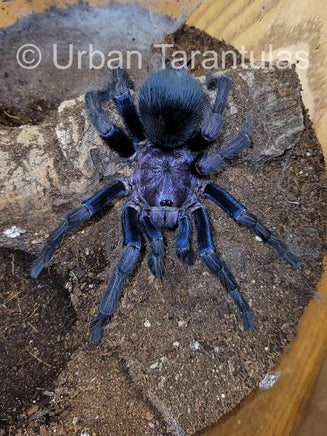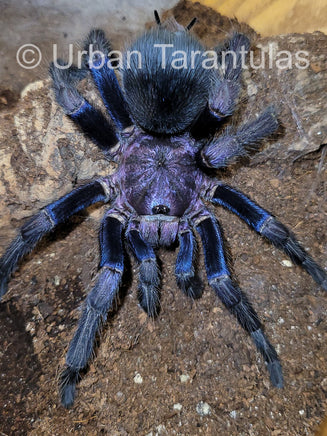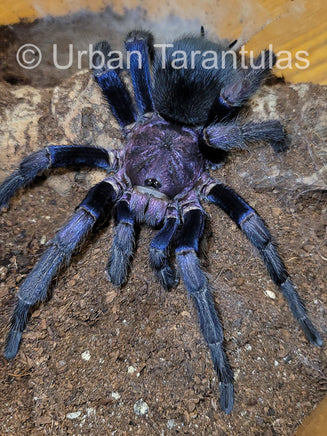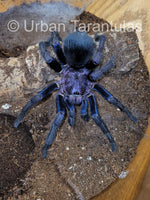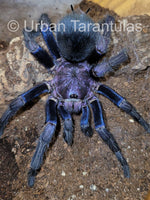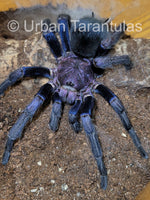Introduction
Meet the stunning Phormictopus dominican purple, a tarantula that boasts an extraordinary color palette, transforming from vibrant purples to subtle metallic hues as it matures. This species is a remarkable sight in the tarantula community, making it a sought-after addition for enthusiasts who appreciate beauty and uniqueness in their collection.
Care Details
-
Temperature: Ideal range for most tarantulas is 75 to 85°F (24 to 27°C). They thrive in warmer environments, eating more, growing faster, and molting quicker. This flexibility in care makes the Phormictopus dominican purple easy to maintain.
-
Humidity: The Phormictopus dominican purple requires a humidity level of about 65-75%. Water dishes are not necessary, but if used, they pose no harm. I personally do not use them.
-
Housing: As a terrestrial species, the Phormictopus dominican purple starts its life in a 1 oz to 4 oz deli container with needle-made ventilation. As it grows, it will need an enclosure 2 to 3 times its size, offering some flexibility.
-
Diet: I personally give them a variety of crickets and cockroaches, including Dubia, Red-runner, Lobster, and Madagascar hissing roaches. For the baby tarantulas, baby crickets and baby roaches are ideal. If you cannot find a small enough cricket or cockroach, just crush its head and leave it in the enclosure; your tarantula should handle the rest. Remember to remove any uneaten food to prevent any mold growth. And for an occasional treat, a pinky or hopper mouse adds a nice variety to their diet. Make sure not to overfeed rodents and feeder lizards to your tarantulas; these should be done every once in a while as a treat. Too much calcium is not good for the tarantula as it can cause compaction and the tarantula might have a hard time pooping.
In-depth Facts
- Latin name: Phormictopus sp. purple
- Common name: Dominican Purple Tarantula
- Locale: Originating from the Dominican Republic, this species is a testament to the diverse and vibrant life found within the island's ecosystems.
- Category: Terrestrial, with a tendency for minimal webbing.
- Size: Females can grow up to 7-8.5 inches in leg span, with males slightly smaller, showcasing the species' impressive stature.
- Urticating hairs: Yes, it possesses urticating hairs as a defense mechanism.
- Growth rate: They are known for their relatively fast growth rate, reaching maturity in a few years.
- Life span: Females can live up to 15-20 years, while males have a shorter lifespan, typically around 4-5 years.
- Recommended levels: Suitable for keepers of all experience that love tarantulas with a little bit of spice!
Stay Connected
- Instagram: Follow my Instagram, I'm most active here.
- YouTube: For care and education videos, check out my YouTube channel.
- Facebook: Over here I have all my reviews.
- TikTok: Visit my TikTok for additional content.
Safety Disclaimer
Experiencing a tarantula bite is an extremely rare occurrence, and it's important to note that there have been no recorded fatalities due to a tarantula bite. The venom potency varies across species, with Old World tarantulas generally having stronger venom than their New World counterparts. Within the Old World category, the Poecilotheria genus is known for having particularly potent venom.
It's crucial to approach tarantulas with respect and understanding. If you happen to get bitten, which is unlikely, the key is to stay calm. In most cases, the discomfort is superficial and subsides within a few minutes to a few hours. However, bites from species with more potent venom may result in symptoms lasting up to a week. Remember, larger tarantulas tend to have more venom than smaller ones.
Please be aware that I cannot assume responsibility for bites. Tarantula handling should be done at your own risk. In my 11 years of experience with these creatures, I have only been bitten once, by a species with highly potent venom. While the experience was painful, the symptoms had completely disappeared after a week.
Handle tarantulas responsibly, and always prioritize your safety and the well-being of the tarantula.
